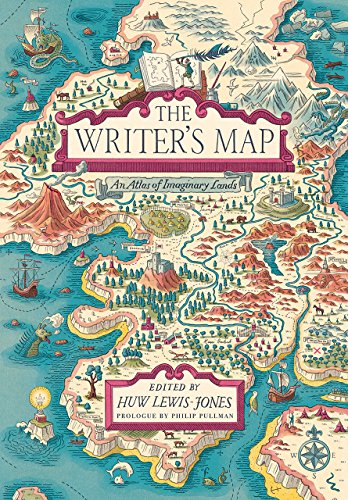![]() The Writer’s Map: An Atlas of Imaginary Lands edited by Hue Lewis-Jones
The Writer’s Map: An Atlas of Imaginary Lands edited by Hue Lewis-Jones
 Before I get into the review proper of Hue Lewis-Jones’ The Writer’s Map: An Atlas of Imaginary Lands, I have to note up front that my digital copies of the book had major formatting issues so that passages were jumbled up such that one paragraph would end and a wholly unrelated paragraph (one from either earlier or later in the book) would follow. Or the book would just stop, with pages from, say 25 onward, just being a sea of white. These issues arose on both my iPad and my Kindle, no matter how many times I downloaded a new version and deleted the old. I’m assuming the problem is just an artifact of the Advanced Reader’s Copy and won’t occur with purchased versions, but it had, as you might imagine, a bit of a deleterious effect on my own reading experience. Something to keep in mind.
Before I get into the review proper of Hue Lewis-Jones’ The Writer’s Map: An Atlas of Imaginary Lands, I have to note up front that my digital copies of the book had major formatting issues so that passages were jumbled up such that one paragraph would end and a wholly unrelated paragraph (one from either earlier or later in the book) would follow. Or the book would just stop, with pages from, say 25 onward, just being a sea of white. These issues arose on both my iPad and my Kindle, no matter how many times I downloaded a new version and deleted the old. I’m assuming the problem is just an artifact of the Advanced Reader’s Copy and won’t occur with purchased versions, but it had, as you might imagine, a bit of a deleterious effect on my own reading experience. Something to keep in mind.
The book itself is a collection of essays by authors (and a few artists) about maps, sometimes maps in general but more often literary maps in particular — book maps they fell in love with as child readers, rough sketches of maps they made for personal use while creating their own imaginary worlds, or gorgeously finalized maps that appeared in their books. Included with the essays are the maps themselves, nearly two-hundred full-color ones, making the book as much a visual treat as a narrative one.
As with any collection, the quality of the individual essays within The Writer’s Map vary, though none are worse than solidly engaging thanks to the personal voice of each author. In other words, while some essays are a bit slight, or not particularly interesting or insightful, none could be labeled “bad.” The authors/artists include Philip Pullman, David Mitchell, Lev Grossman, Cressia Cowell, Chris Riddell, Brian Selznick, and Isabel Grenerg, amongst others. Some write adult fiction, some YA/MG or children’s books, some make maps for books and/or films. Some do all of those.
There’s a definite English-ness to some of the texts/shows/films referenced and though I didn’t find that a detriment to enjoying the essays, awareness of some of those references will almost certainly enhance the experience. What did detract a bit for me was the repetitiveness that occasionally cropped (lots of references, for instance, to Treasure Island or Robinson Crusoe). While certainly not a major flaw, it was definitely noticeable, and while some such repetitiveness could be expected thanks to everyone focusing on the same topic, some editing or maybe even some notification to authors of topics already covered (“You might want to skip over Robert Louis Stevenson if you were planning on mentioning him … “) would have negated some of what arises.
Among the essays, some of my favorites were by Robert McFarlane (one of the more insightful and semi-academic ones), Miraphora Mina (for its fascinating specificity on her creation of the Marauder’s Map for the Harry Potter films), Lev Grossman (for his smooth move from the intimately personal to broader societal analysis), and David Mitchell for his humor. Others, as noted, vary in impact and interest, but most offered up some new tidbit of information I hadn’t been aware of, despite my keen interest and extensive reading in the area.
Visually, the book is stellar. The maps are gorgeously recreated and cover a wide spectrum of type, style, time period, and intent. If you’re like me, you’ll spend a lot of time lingering over the images long past the time you finished an essay’s particular text.
I wouldn’t call The Writer’s Map an in-depth look at maps in literature or society. But as a collection of light, brief, often interesting, almost always personal stories by those who have been inspired by them and use them in their own works, the anthology is certainly a success, one enhanced by the excellent visuals. I’ll be picking up a physical copy, myself.



I will definitely have to keep an eye out for this one — I love fictional maps! Thanks for putting it on my radar, Bill, and I’m glad you enjoyed it.
What a fun idea! It’s always enjoyable to learn the reasons behind art, and I remember pouring over a map or two in some magical books growing up.
This book is getting so much buzz! And it’s another one to go on my Christmas list.